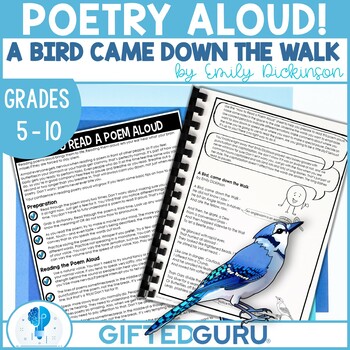A Bird Came Down the Walk Emily Dickinson Read Poetry Aloud Oral Reading
- PDF
What educators are saying
Also included in
- Looking for poetry resources that will get your students excited about poetry and meet loads of standards at the same time? This bundle is for you! You'll get five different lesson plans that will invigorate your Language Arts class.In this bundle, you'll find a variety of lessons that teach poems tPrice $8.00Original Price $10.50Save $2.50
Description
Reading poetry out loud can be easy if you know the tips and tricks! This lesson uses Emily Dickinson's poem "A Bird Came Down the Walk" to teach oral reading of poetry. It's an often overlooked standard, but no more! Your students will use these skills for years to come.
You'll get a fabulous "How to Read a Poem Aloud" tip sheet that you'll come back to again and again.
Students will use this along with a planning sheet for "A Bird Came Down the Walk" to prepare to read the poem aloud.
Students will learn about Emily Dickinson's poem "A Bird Came Down the Walk," but they'll also learn oral poetry reading skills!
This Poetry "A Bird Came Down the Walk" Resource includes:
✅ "How to Read a Poem Aloud" handout
✅ Detailed teacher instructions and ideas
✅ "A Bird Came Down the Walk" planning sheet
✅ Rubric
You could not get any more low-prep than this! Make some copies and you're done! You will have very clear, step-by-step instructions for what to do to teach the lesson.
You'll find this resource is perfect for fourth grade through tenth grade students, and it's also wonderful for homeschoolers.
--------------
⭐⭐WILLIAMS' MODEL OF CREATIVITY ⭐⭐
This lesson is based on Williams' Model of Creativity, a model designed to develop the traits of creativity in students. This particular resource focuses on this trait:
☀️ Risk-taking - the ability to stretch beyond our comfort zone and take risks cognitively or personally
IF YOU LIKE QUALITY ACTIVITIES FOR YOUR STUDENTS, YOU MAY ALSO WANT:
✨ National Poetry Month Activities | Cinquain Poem Mini Unit
✨ Thesaurus and Poetry Writing Robert Frost's Dust of Snow Early & Middle Grades
✨ Poetry: Fog by Carl Sandburg Figurative Language Zoomorphism Activity
✨ Literary Elements Secret Picture Tiles BUNDLE
✨ Vocabulary Concept Capsules Set 1: Literary Elements English Language Arts
In addition to addressing standards and providing an engaging and effective classroom experience, these activities will also build students' creativity skills.
Connect with me!
✨ Be sure to follow my TpT store by clicking on the red ‘Follow Me’ next to my Seller picture to receive notifications of new products and upcoming sales.
✨ Come on over to Facebook or Instagram and join in the Gifted Guru ideas and tips fun!






